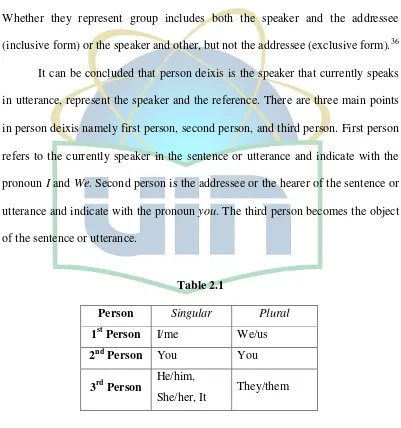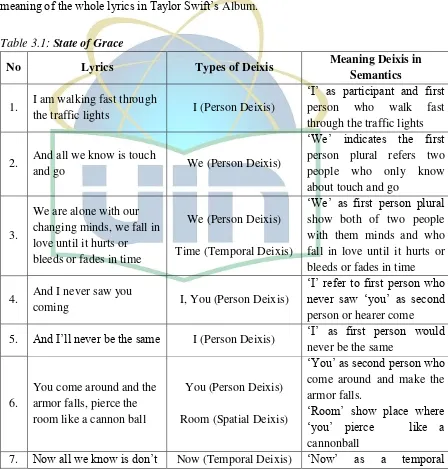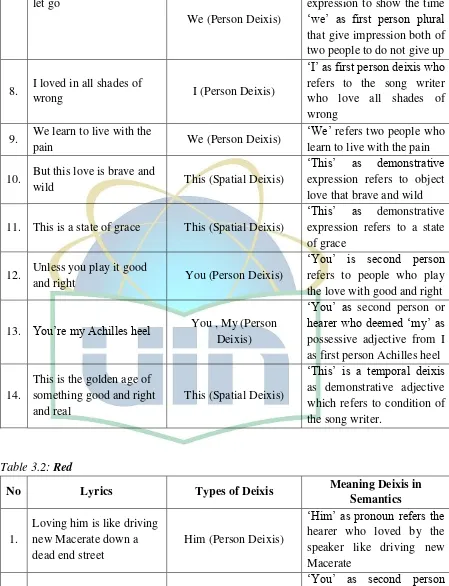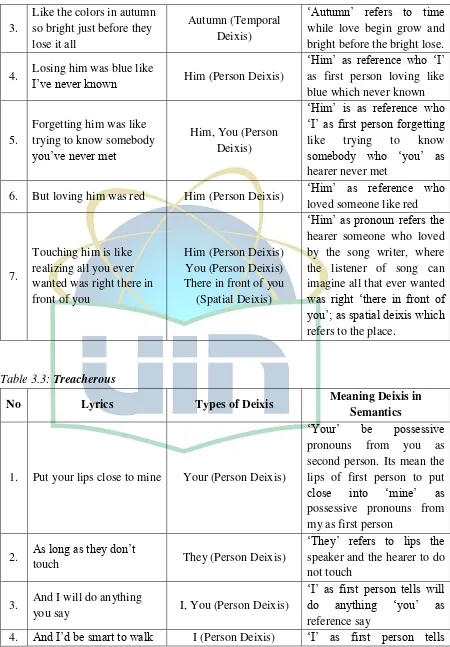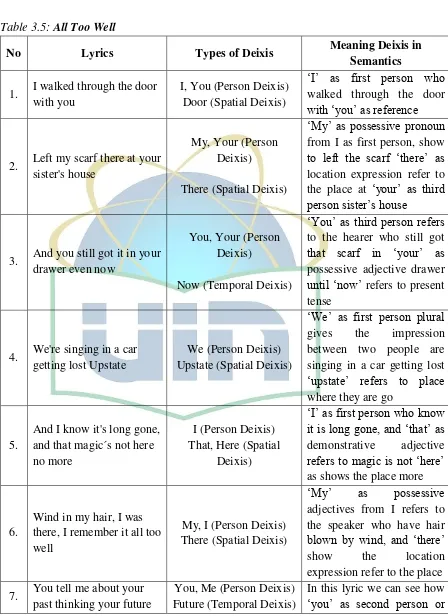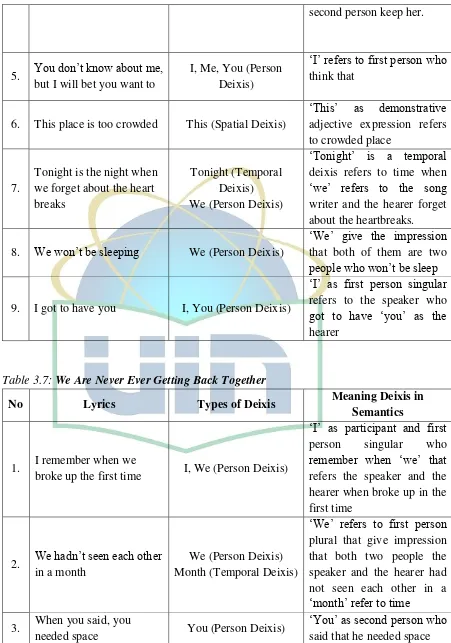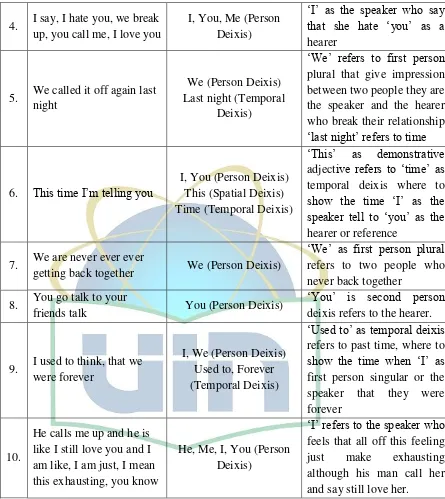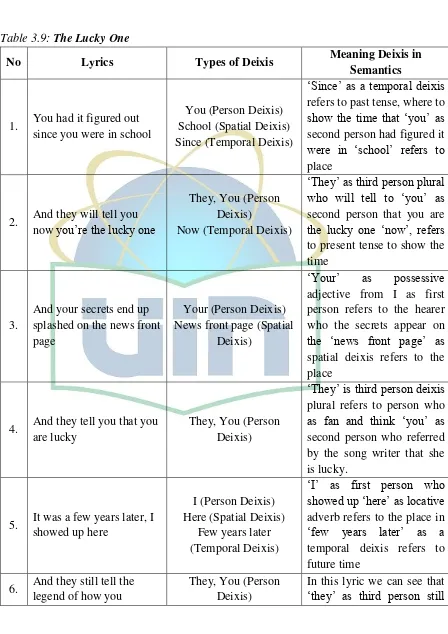Informasi Dokumen
- Penulis:
- Debi Ratna Wati
- Pengajar:
- Dr. Muhammad Farkhan, M.Pd.
- Drs. Saefudin, M.Pd.
- Sekolah: State Islamic University Syarif Hidayatullah Jakarta
- Mata Pelajaran: English Letters Department
- Topik: A Deixis Analysis of Song Lyrics in Taylor Swift’s “Red” Album
- Tipe: thesis
- Tahun: 2014
- Kota: Jakarta
Ringkasan Dokumen
I. Introduction
This section introduces the significance of analyzing deixis in Taylor Swift's 'Red' album. It emphasizes the role of music as a cultural artifact that conveys social realities and emotions through lyrics. The study aims to explore how deixis enhances the understanding of meaning in song lyrics, facilitating a deeper connection between the listener and the text.
II. Theoretical Framework
This section discusses the theoretical underpinnings of deixis, including its definitions and types as proposed by linguists like John I. Saeed. It establishes the importance of semantics and pragmatics in understanding the context of language use, particularly in song lyrics. The section also reviews previous research on deixis, highlighting its relevance in various literary forms.
2.1. Previous Research
This subsection reviews previous studies on deixis, showcasing various research perspectives and methodologies. It emphasizes the diversity of deixis applications in different texts, including literature and film scripts, and sets the stage for the current analysis of song lyrics.
2.2. Semantics
This subsection defines semantics and its role in understanding meaning within language. It discusses key contributions from linguists and the importance of semantic analysis in interpreting song lyrics, particularly in understanding deixis.
2.3. Pragmatics
This subsection explores pragmatics and its relationship with deixis. It highlights how context influences the interpretation of meaning in communication, particularly in the analysis of song lyrics.
2.4. Context
This subsection elaborates on the concept of context in linguistic analysis. It emphasizes the necessity of situational context in interpreting deixis, particularly in song lyrics where emotional and situational nuances play a crucial role.
2.5. Meaning
This subsection discusses the nature of meaning in language, focusing on how semantics contributes to understanding word and sentence meanings in song lyrics. It emphasizes the role of deixis in conveying nuanced meanings.
2.6. Deixis
This subsection provides a comprehensive definition of deixis, detailing its function in language as a means of pointing to specific entities in context. It sets the foundation for analyzing deixis in song lyrics.
2.7. Types of Deixis
This subsection categorizes deixis into person, spatial, and temporal deixis. Each type is defined and exemplified, establishing a framework for the analysis of Taylor Swift's lyrics.
III. Research Findings
This section presents the findings of the deixis analysis conducted on Taylor Swift's 'Red' album. It systematically categorizes the identified deixis types from the lyrics, illustrating how they contribute to the overall meaning of the songs. The analysis reveals patterns in the use of deixis and its impact on listener interpretation.
3.1. Data Description
This subsection describes the data collection process, outlining the selection of song lyrics from the 'Red' album and the methodology used for analysis. It emphasizes the qualitative approach taken to explore the deixis present in the lyrics.
3.2. Person Deixis
This subsection analyzes the use of person deixis in the lyrics, identifying first, second, and third-person references. It discusses how these references shape the emotional and relational dynamics presented in the songs.
3.3. Spatial Deixis
This subsection examines spatial deixis in the lyrics, highlighting how location references enhance the imagery and emotional resonance of the songs. It discusses the implications of spatial references for listener interpretation.
3.4. Temporal Deixis
This subsection focuses on temporal deixis, analyzing how time references in the lyrics contribute to the narrative structure and emotional depth of the songs. It discusses the significance of temporal context in understanding the lyrics.
IV. Conclusions and Suggestions
This section summarizes the key findings of the research, highlighting the importance of deixis in enhancing the understanding of song lyrics. It suggests practical applications for educators and researchers interested in using song lyrics as pedagogical tools for teaching semantics and pragmatics.
4.1. Conclusions
This subsection encapsulates the main conclusions drawn from the deixis analysis, emphasizing its relevance to understanding meaning in song lyrics and its implications for listeners.
4.2. Suggestions
This subsection offers suggestions for future research and practical applications of deixis analysis in educational contexts, encouraging further exploration of song lyrics as a means of teaching linguistic concepts.
Referensi Dokumen
- Semantics: A New Outline ( F. R. Palmer )
- Semantics ( John I. Saeed )
- Linguistics ( H.G. Widdowson )
- The Study of Language ( George Yule )
- Oxford Advanced Learner's Dictionary ( Oxford University Press )
